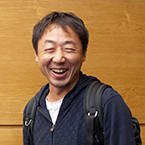contents
Director
Director's Message
What comes to mind when you hear the term "civil engineering"?
If we were to compare it to a play, the cast that many of you are most likely familiar with may include roads, tunnels, railroads, rivers and parks. By far the main stars here are bridges. The characters that support them from behind the scenes are waterworks, telecommunications and surveying technologies. And dams may perhaps be a major actor fit to play the role of a villain. As you can see, civil engineering has just such a diverse and colorful cast working hard to build advanced networks while confronting harsh but rich nature, to support your daily lives as a single, united team. The fact is, however, the values that civil engineering provides on a daily basis is so ubiquitous that people simply take it for granted and never stop and think about it. On the contrary, the only times civil engineering makes news is at the end of the fiscal year when roadworks increase and cause floods of complaints from area residents, and during times of disaster when infrastructure collapses and fails. The fact that civil engineering is talked about only during times of emergency, and in a negative way at that, is a problem for those involved in this business.
At this "DOBOKU: Civil Engineering" Exhibition, I hope to give the center stage to civil engineering which has consistently played an unseen, supporting role, and visualize it with fun and beautiful images. A full-fledged exhibition that features a collaboration between steadfast, no-nonsense civil engineering and creators from a completely different area of specialty, is a first-ever attempt in this industry. I, too, am eagerly looking forward to seeing what unique and wonderful perspectives the exhibits will show us.
Since the Meiji era that began in late 19th century, Japan has learned numerous cutting-edge technologies from the West, and walked the path toward modernization. During the postwar high economic growth period, in particular, with our predecessors' passion and efforts, Japan built world-class infrastructures with amazing speed, giving us the easy, comfortable lives which we enjoy today. On the other hand, I also feel that civilization, which has single-mindedly brought about convenience to our lives, is degrading the human instinct for survival. As symbolized by the difference between the Tokyo Olympics of 1964, and the Tokyo Olympics 2020 that is drawing near, society's concept of values is changing dramatically. It appears to me that now is the time to ask ourselves once again what happiness is all about, as we look to the future.
Five years have already passed since the 2011 Great East Japan Earthquake. As we were preparing this "DOBOKU: Civil Engineering" Exhibition in order to support as much as possible the future of the Tohoku region - still midway through reconstruction - disaster struck again in the Kyushu region this time with earthquakes originating in Kumamoto with the biggest earthquake measuring 7 on the seismic intensity scale. Infrastructure such as roads, railways, and water and sewage systems were readily destroyed and once again, many citizens lost their regular daily lives. Faced with the overpowering energy of the Earth like that of a massive creature, I was once again dumbfounded by the helplessness of people to fight against it.
How should we face Mother Nature, which far exceeds the wisdom of mankind?
I feel that these two recent disasters demand our return to a pre-cultural philosophy. I sincerely hope that this "DOBOKU: Civil Engineering" Exhibition will bring civil engineering closer to you, and make it an opportunity to reexamine the difficult-to-see aspects of your daily lives as something relevant to you.
Hiroshi Nishimura
Profile

Hiroshi Nishimura
Architect, designer and creative director
Representative Director, WORKVISIONS Inc.; Board Director, Renovaring Inc.
Representative, Machinoshigotoba COTOCO215
Born in 1967 in Saga Prefecture. Graduated from the Department of Civil Engineering, Faculty of Engineering, the University of Tokyo, and completed a Master's degree at the Department of Engineering, the University of Tokyo Graduate School of Engineering. In 1999, he established WORKVISIONS Inc., a registered architects' office. Despite coming from a civil engineering background, he went on his own in the world of architecture and currently is actively engaged in broad-ranging businesses, from drawing up urban revival strategies to conducting planning and design in the architecture, renovation and civil engineering sectors, and also urban development that ranges from project direction to operating a co-working space. He has received numerous awards including the Architectural Institute of Japan Award (works), the Japan Society of Civil Engineers' Design Award, the BCS Award, the Brunel Award, the Arcasia Awards for Architecture, and the Public Building Award. The Complex Station Building in Iwamizawa, Hokkaido which was completed in 2009, received the 2009 Good Design Award's Grand Prize.

